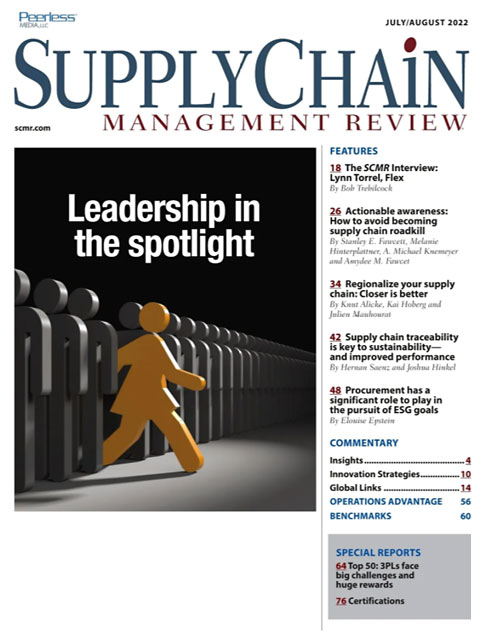Sorry, but your login has failed. Please recheck your login information and resubmit. If your subscription has expired, renew here.
July-August 2022
In late May, I attended the Institute for Supply Management’s first live conference since 2019. The message from Tom Derry, ISM’s CEO, was simple: These are challenging times, but along with the challenges come opportunities for those of us who can step up and lead our organizations into the future. One area where supply chain will be tasked with stepping up to the plate is going to be ESG, the initialism for environmental, social and governance. It was a major theme of the conference, and while all of the reporting requirements are still being debated, there’s little question that supply chain will lead the charge in environmental initiatives… Browse this issue archive.Need Help? Contact customer service 847-559-7581 More options
Digital twins (DTs)—living digital replicas of physical entities—are used widely in manufacturing to mimic and improve real-world processes and systems. However, there are far fewer applications of the technology in supply chain management. DTs could deliver similar benefits in supply chains if it were not for certain misconceptions that prevent companies from unlocking the technology’s huge potential.
Contrary to these mistaken beliefs, DT technology is accessible and can be implemented in well-defined steps. And as is the case with any new, innovative technology, companies need to understand what they want to achieve before implementing it.
Pioneering projects
Digital twins can deliver efficiency gains in a wide variety of supply chain functional areas. Here are some illustrative examples.
- The consolidation of shipments in distribution centers.
- Optimizing the size of freight transportation fleets.
- Testing different warehouse layouts.
- Adjusting goods flows and routing, in alignment with demand.
- The tracking of assets in real-time.
- Supporting predictive maintenance programs.
An early adopter of digital twin technology in manufacturing operations, the $13 billion packaging company Tetra Pak, built a digital version of a warehouse in Southeast Asia together with logistics services provider DHL. A continuous stream of operational data harvested from the physical facility’s Internet of Things (IoT) infrastructure feeds the digital model. The warehouse digital twin is used in a variety of ways. It helps Tetra Pak to dynamically adjust stock locations, manage inventory as well as seasonality and shifts in demand, balance workflows and allocate equipment in the physical warehouse. These applications enable the company to optimize storage space utilization and improve both operational efficiency and workplace safety standards.

This complete article is available to subscribers only.
Log in now for full access or start your PLUS+ subscription for instant access.
SC
MR
Sorry, but your login has failed. Please recheck your login information and resubmit. If your subscription has expired, renew here.
July-August 2022
In late May, I attended the Institute for Supply Management’s first live conference since 2019. The message from Tom Derry, ISM’s CEO, was simple: These are challenging times, but along with the challenges come… Browse this issue archive. Access your online digital edition. Download a PDF file of the July-August 2022 issue.Digital twins (DTs)—living digital replicas of physical entities—are used widely in manufacturing to mimic and improve real-world processes and systems. However, there are far fewer applications of the technology in supply chain management. DTs could deliver similar benefits in supply chains if it were not for certain misconceptions that prevent companies from unlocking the technology’s huge potential.
Contrary to these mistaken beliefs, DT technology is accessible and can be implemented in well-defined steps. And as is the case with any new, innovative technology, companies need to understand what they want to achieve before implementing it.
Pioneering projects
Digital twins can deliver efficiency gains in a wide variety of supply chain functional areas. Here are some illustrative examples.
- The consolidation of shipments in distribution centers.
- Optimizing the size of freight transportation fleets.
- Testing different warehouse layouts.
- Adjusting goods flows and routing, in alignment with demand.
- The tracking of assets in real-time.
- Supporting predictive maintenance programs.
An early adopter of digital twin technology in manufacturing operations, the $13 billion packaging company Tetra Pak, built a digital version of a warehouse in Southeast Asia together with logistics services provider DHL. A continuous stream of operational data harvested from the physical facility’s Internet of Things (IoT) infrastructure feeds the digital model. The warehouse digital twin is used in a variety of ways. It helps Tetra Pak to dynamically adjust stock locations, manage inventory as well as seasonality and shifts in demand, balance workflows and allocate equipment in the physical warehouse. These applications enable the company to optimize storage space utilization and improve both operational efficiency and workplace safety standards.
SC
MR


Latest Supply Chain News
- Made in Mexico, manufactured by China
- Retail sales see gains in October, reports Commerce and NRF
- Balancing green and speed: Home delivery insights from the pandemic era
- AdventHealth named top healthcare supply chain by Gartner
- Geopolitical readiness in supply chains: Strategic challenges for leaders
- More News
Latest Podcast

 Explore
Explore
Software & Technology News
- Nine questions are the key to AI success in building resilient supply chains
- Looking back at NextGen 2024
- AI is moving omnichannel closer to the customer
- How technological innovation is paving the way for a carbon-free future in logistics and supply chains
- Körber Supply Chain Software’s Craig Moore says MercuryGate acquisition is about the customer
- Robotic use grows by 10%
- More Software & Technology
Latest Software & Technology Resources

Subscribe

Supply Chain Management Review delivers the best industry content.

Editors’ Picks





